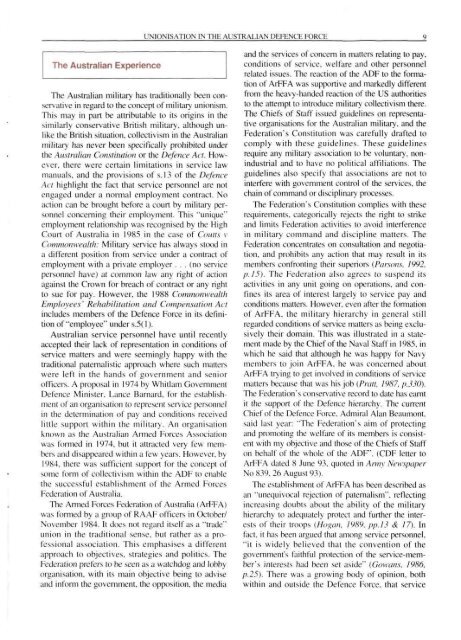ISSUE 107 : Jul/Aug - 1994 - Australian Defence Force Journal
ISSUE 107 : Jul/Aug - 1994 - Australian Defence Force Journal
ISSUE 107 : Jul/Aug - 1994 - Australian Defence Force Journal
You also want an ePaper? Increase the reach of your titles
YUMPU automatically turns print PDFs into web optimized ePapers that Google loves.
UNIONISATION IN THE AUSTRALIAN DEFENCE FORCE 9The <strong>Australian</strong> ExperienceThe <strong>Australian</strong> military has traditionally been conservativein regard to the concept of military unionism.This may in part be attributable to its origins in thesimilarly conservative British military, although unlikethe British situation, collectivism in the <strong>Australian</strong>military has never been specifically prohibited underthe <strong>Australian</strong> Constitution or the <strong>Defence</strong> Act. However,there were certain limitations in service lawmanuals, and the provisions of s. 13 of the <strong>Defence</strong>Act highlight the fact that service personnel are notengaged under a normal employment contract. Noaction can be brought before a court by military personnelconcerning their employment. This "unique"employment relationship was recognised by the HighCourt of Australia in 1985 in the case of Coutts vCommonwealth: Military service has always stood ina different position from service under a contract ofemployment with a private employer . . . (no servicepersonnel have) at common law any right of actionagainst the Crown for breach of contract or any rightto sue for pay. However, the 1988 CommonwealthEmployees' Rehabilitation and Compensation Actincludes members of the <strong>Defence</strong> <strong>Force</strong> in its definitionof "employee" under s.5( 1).<strong>Australian</strong> service personnel have until recentlyaccepted their lack of representation in conditions ofservice matters and were seemingly happy with thetraditional paternalistic approach where such matterswere left in the hands of government and seniorofficers. A proposal in 1974 by Whitlam Government<strong>Defence</strong> Minister. Lance Barnard, for the establishmentof an organisation to represent service personnelin the determination of pay and conditions receivedlittle support within the military. An organisationknown as the <strong>Australian</strong> Armed <strong>Force</strong>s Associationwas formed in 1974, but it attracted very few membersand disappeared within a few years. However, by1984. there was sufficient support for the concept ofsome form of collectivism within the ADF to enablethe successful establishment of the Armed <strong>Force</strong>sFederation of Australia.The Armed <strong>Force</strong>s Federation of Australia (ArFFA)was formed by a group of RAAF officers in October/November 1984. It does not regard itself as a "trade"union in the traditional sense, but rather as a professionalassociation. This emphasises a differentapproach to objectives, strategies and politics. TheFederation prefers to be seen as a watchdog and lobbyorganisation, with its main objective being to adviseand inform the government, the opposition, the mediaand the services of concern in matters relating to pay.conditions of service, welfare and other personnelrelated issues. The reaction of the ADF to the formationof ArFFA was supportive and markedly differentfrom the heavy-handed reaction of the US authoritiesto the attempt to introduce military collectivism there.The Chiefs of Staff issued guidelines on representativeorganisations for the <strong>Australian</strong> military, and theFederation's Constitution was carefully drafted tocomply with these guidelines. These guidelinesrequire any military association to be voluntary, nonindustrialand to have no political affiliations. Theguidelines also specify that associations are not tointerfere with government control of the services, thechain of command or disciplinary processes.The Federation's Constitution complies with theserequirements, categorically rejects the right to strikeand limits Federation activities to avoid interferencein military command and discipline matters. TheFederation concentrates on consultation and negotiation,and prohibits any action that may result in itsmembers confronting their superiors {Parsons. 1992,p. 15). The Federation also agrees to suspend itsactivities in any unit going on operations, and confinesits area of interest largely to service pay andconditions matters. However, even after the formationof ArFFA, the military hierarchy in general stillregarded conditions of service matters as being exclusivelytheir domain. This was illustrated in a statementmade by the Chief of the Naval Staff in 1985. inwhich he said that although he was happy for Navymembers to join ArFFA. he was concerned aboutArFFA trying to get involved in conditions of servicematters because that was his job (Pratt. 1987. p.330).The Federation's conservative record to date has eamtit the support of the <strong>Defence</strong> hierarchy. The currentChief of the <strong>Defence</strong> <strong>Force</strong>. Admiral Alan Beaumont,said last year: "The Federation's aim of protectingand promoting the welfare of its members is consistentwith my objective and those of the Chiefs of Staffon behalf of the whole of the ADF'. (CDF letter toArFFA dated 8 June 93. quoted in Annx NewspaperNo 839. 26 <strong>Aug</strong>ust 93).The establishment of ArFFA has been described asan "unequivocal rejection of paternalism", reflectingincreasing doubts about the ability of the militaryhierarchy to adequately protect and further the interestsof their troops (Hogan, 19H9. pp. 13 & 17). Infact, it has been argued that among service personnel,"it is widely believed that the convention of thegovernment's faithful protection of the service-member'sinterests had been set aside" (Gowans. 1986.p.25). There was a growing body of opinion, bothwithin and outside the <strong>Defence</strong> <strong>Force</strong>, that service
















